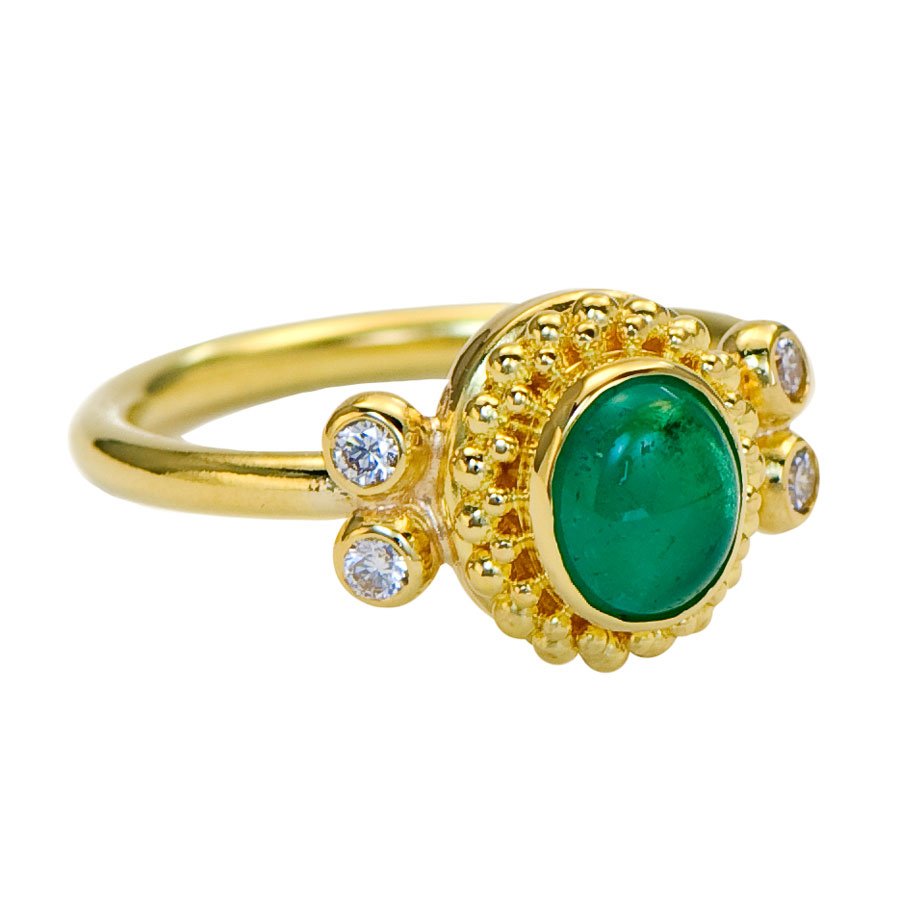Shop Ethically Sourced Emerald & Green Gemstone Jewelry
EMERALD vs GARNET vs TOURMALINE
Emeralds are among the most valuable gemstones with a riveting history across ancient cultures and throughout time. Mesoamerican tribes offered them to their gods, and Cleopatra famously loved emeralds.
A natural attribute of emerald is the presence of “inclusions”. Only the rarest of the rare emeralds have few inclusions. Looking into these gemstones is like a walk in Mother Nature’s “jardin” (French for garden). These perfect imperfections are what make them uniquely beautiful... just like us as women!
As your fine jewelry advisor, I’ve curated a selection of emerald jewelry and her stunning emerald-hued doppelgängers!
SHOP DESIGNER EMERALD JEWELRY
What is the “ideal” emerald?
In terms of what the market values most, this is classified as exhibiting rich, dark greens to bluish-greens. That said, lighter green shades can be incredibly enchanting, as are other gemstones that display similar emerald hues!
Meet Equally Gorgeous Emerald-hued Doppelgängers
Emerald’s gorgeous doppelgängers include garnet, tourmaline, and even sapphire! All of these gemstones can exhibit similar hues - and can be more durable, attainable options that are equally alluring.
SHOP EMERALD LOOK ALIKES
Ready for personalized shopping support for ethically sourced emerald jewelry? Connect with Melissa!
Conscious Luxury & Responsible Sourcing
I believe luxury is synonymous with responsibility, intention, and connection. The emerald jewelry you choose can protect people, place, and planet. This means partnering with celebrated designers who create thoughtfully designed future heirlooms with responsibly sourced emeralds and other emerald-hued gemstones.
Love the topic of gemstone look-alikes?
Meet RUBY and her gorgeous DOPPELGÄNGERS!
Frequently Asked Questions about Investment-Quality Emeralds & Green Gemstone Jewelry
What defines an “investment-quality” emerald, and how does All The Brilliants source them?
An investment-quality emerald has exceptional color (deep green to bluish-green hue) with few inclusions, good clarity, and is a precision cut to maximize brilliance. When investing in emeralds for bespoke jewelry, I work with vetted gemstone suppliers who have long-term relationships with artisanal mining communities that can provide provenance and have a full chain of custody. Additionally, emerald investment pieces are accompanied by gemological reports, ensuring authenticity and quality for our discerning collectors. While our focus is on Colombian emerald quality hues, coveted emeralds can also be sourced from Zambia.
Are emeralds a good investment compared to other gemstones or assets?
Yes. Historically, high-quality, responsibly sourced emeralds have shown consistent value appreciation. This is due to their rarity and demand in the market. Since 1995, the value of natural, untreated emeralds has at least tripled. Investment-quality emeralds can be a valuable tangible asset, bringing diversity to a portfolio, and a beautiful heirloom that can be enjoyed. While significant diamonds can be a stable asset, rare colored gemstones like emeralds have an even more limited supply with growing demand. Emeralds are an appealing, unique investment for those seeking to diversify their jewelry collection.
How do you ensure the ethical sourcing and sustainability practices of your emeralds and other green gemstones?
Short, transparent supply chains. For bespoke jewelry, my vetted gemstone partners are leaders in responsible sourcing. This practice goes beyond being ethical and conflict-free. Responsible sourcing is a more holistic goal, which protects and respects people, their skills, and the natural environment as much as possible. This includes fair labor practices, safe working conditions, minimizing environmental impact during extraction, land reclamation, and traceability of the gemstone’s journey from the mine to you.
The designers you find on All The Brilliants are at different places in their sourcing journey, and we disclose as much information as is available.
What are the best alternatives to emeralds for luxury jewelry, especially if I’m looking for greater durability?
While emeralds are a 7.5-8 on the Mohs scale, they are brittle due to their natural inclusions. This makes them more susceptible to damage due to accidental bumps with hard surfaces. For those seeking durable green gemstones with emerald hues, Tsavorite garnet, green tourmaline, and green sapphire are beautiful options. Tsavorite garnets have a striking, vivid green with excellent durability (7-7.5 on the Mohs scale), while green sapphires are incredibly hard (9 on the Mohs scale) and can exhibit a range of beautiful greens. Green tourmaline provides a diverse palette of greens and good durability (7-7.5 on the Mohs scale). These high-end emerald alternatives offer both beauty and practicality for active lifestyles.
I’m looking for a significant luxury gift for my wife. How can your jewelry concierge service assist me?
My high-touch jewelry concierge service is designed to protect your time and provide peace of mind when investing in the perfect luxury emerald gift for her. During your private jewelry consultation, we will explore her story, style, and the occasion for her designer gift. I will provide curated suggestions of available, ready-made pieces, or we can create bespoke emerald jewelry made just for her.
Your Intentional Fine Jewelry Concierge
Whether you are expanding your personal collection or seeking the perfect luxury emerald gift for her, I help you invest in designer jewelry that tells your story, elevates your style, and aligns with your values.














